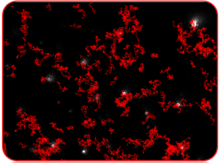- Nanoparticle tracking analysis
-
Nanoparticle Tracking Analysis (NTA) is a method for visualizing and analyzing particles in liquids that relates the rate of Brownian motion to particle size. The rate of movement is related only to the viscosity and temperature of the liquid, it is not influenced by particle density or refractive index. NTA allows the determination of a size distribution profile of small particles (10-1000nm) in liquid suspension.
The technique is used in conjunction with an ultramicroscope which allows small particles in liquid suspension to be visualized moving under Brownian motion. Computer software is then be used to track particles’ movements and subsequently estimate their hydro-dynamic radius, using the Stokes–Einstein equation.
The light scattered by the particles is captured using a CCD or EMCCD camera and the motion of each particle is tracked from frame to frame. This rate of particle movement is related to a sphere equivalent hydrodynamic radius as calculated through the Stokes–Einstein equation. The technique calculates particle size on a particle-by particle basis overcoming inherent weaknesses in ensemble techniques [1]. Since video clips form the basis of the analysis, accurate characterisation of real time events such as aggregation and dissolution is possible.
Samples require minimal preparation so the time required to process one sample is much reduced. Speculators suggest that eventually the analysis may be done in real-time with no preparation e.g. when detecting the presence of viruses or biological weapons in air.
NTA currently operates for particles from 10 to 2,000 nm, depending on particle type. Analysis of 10 nm particles is only possible for particles with a high refractive index, such as gold and silver. The upper size limit is restricted by the limited Brownian motion. Above 1 micrometre, the particle moves very slowly and accuracy starts to diminish. The viscosity of the solvent also influences the movement of particles and it too plays a part in determining the upper size limit for a specific system.
Contents
Applications
NTA has proved useful for companies working with:
- Nanoparticle toxicology
- Drug delivery
- Exosomes[disambiguation needed
 ]
] - Virology and vaccine production
- Ecotoxicology
- Protein aggregation
- Orthopedic implants
- Inks and pigments
- Nanobubbles
Comparison to dynamic light scattering (DLS)
Both Dynamic Light Scattering (DLS) and Nanoparticle Tracking Analysis (NTA) measure the Brownian motion of nanoparticles whose speed of motion, or diffusion coefficient, Dt, is related to particle size through the Stokes–Einstein equation.
where
- Dt is the diffusion constant,
- Kb is Boltzmann's constant,
- T is the absolute temperature,
- η is viscosity
- d is the radius of the spherical particle.
In NTA this motion is analyzed by video - individual particle positional changes are tracked in two dimensions from which the particle diffusion is determined. Knowing Dt, the particle hydrodynamic diameter can be then determined.
In contrast, DLS does not visualize the particles individually but analyses, using a digital correlator, the time dependent scattering intensity fluctuations. These fluctuations are caused by interference effects arising from the relative Brownian movements of an ensemble of a large number of particles within a sample. Through analysis of the resultant exponential autocorrelation function, average particle size can be calculated as well as a polydispersity index. For multi-exponential autocorrelation functions arising from polydisperse samples, deconvolution can furnish limited information about the particle size distribution profile.
See also
- NanoSight Ltd
- Dynamic light scattering
References
External links
- [2] explaining the core technology can be downloaded from here.
- The NanoSight homepage for an introduction to the company and applications.
Categories:- Sub-micron microscopy
Wikimedia Foundation. 2010.



